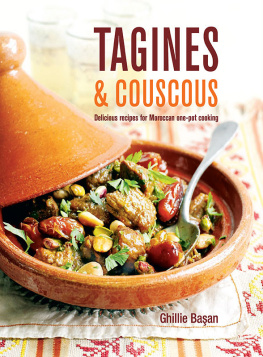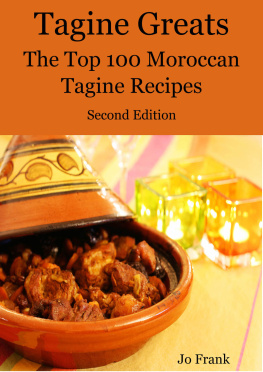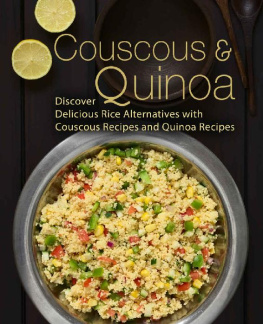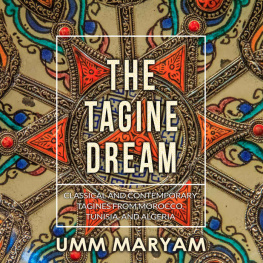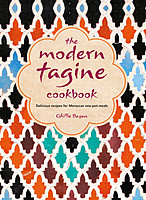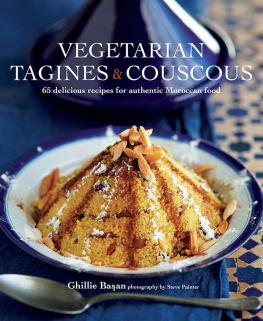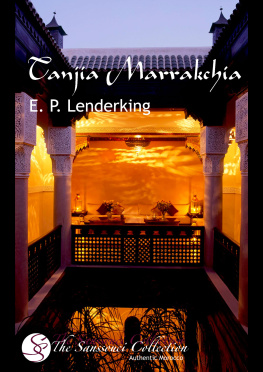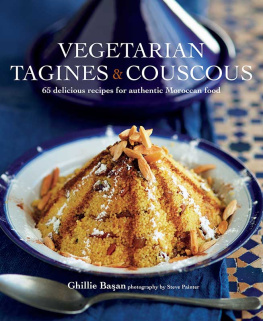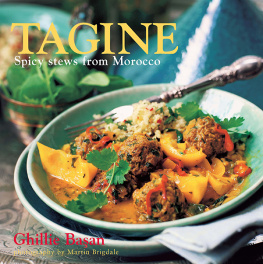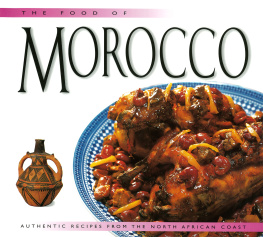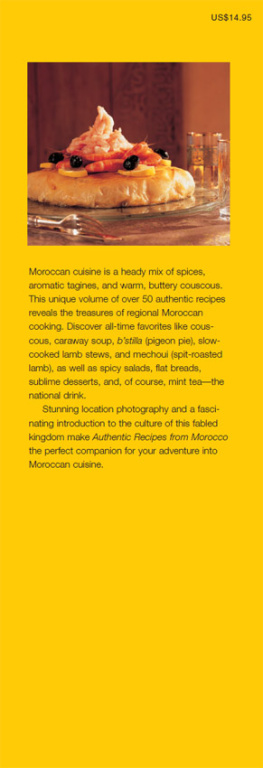Brigdale Martin - Tagines & couscous : delicious recipes for Moroccan one-pot cooking
Here you can read online Brigdale Martin - Tagines & couscous : delicious recipes for Moroccan one-pot cooking full text of the book (entire story) in english for free. Download pdf and epub, get meaning, cover and reviews about this ebook. City: London, year: 2010, publisher: Ryland Peters & Small, genre: Home and family. Description of the work, (preface) as well as reviews are available. Best literature library LitArk.com created for fans of good reading and offers a wide selection of genres:
Romance novel
Science fiction
Adventure
Detective
Science
History
Home and family
Prose
Art
Politics
Computer
Non-fiction
Religion
Business
Children
Humor
Choose a favorite category and find really read worthwhile books. Enjoy immersion in the world of imagination, feel the emotions of the characters or learn something new for yourself, make an fascinating discovery.
- Book:Tagines & couscous : delicious recipes for Moroccan one-pot cooking
- Author:
- Publisher:Ryland Peters & Small
- Genre:
- Year:2010
- City:London
- Rating:5 / 5
- Favourites:Add to favourites
- Your mark:
- 100
- 1
- 2
- 3
- 4
- 5
Tagines & couscous : delicious recipes for Moroccan one-pot cooking: summary, description and annotation
We offer to read an annotation, description, summary or preface (depends on what the author of the book "Tagines & couscous : delicious recipes for Moroccan one-pot cooking" wrote himself). If you haven't found the necessary information about the book — write in the comments, we will try to find it.
Brigdale Martin: author's other books
Who wrote Tagines & couscous : delicious recipes for Moroccan one-pot cooking? Find out the surname, the name of the author of the book and a list of all author's works by series.
Tagines & couscous : delicious recipes for Moroccan one-pot cooking — read online for free the complete book (whole text) full work
Below is the text of the book, divided by pages. System saving the place of the last page read, allows you to conveniently read the book "Tagines & couscous : delicious recipes for Moroccan one-pot cooking" online for free, without having to search again every time where you left off. Put a bookmark, and you can go to the page where you finished reading at any time.
Font size:
Interval:
Bookmark:

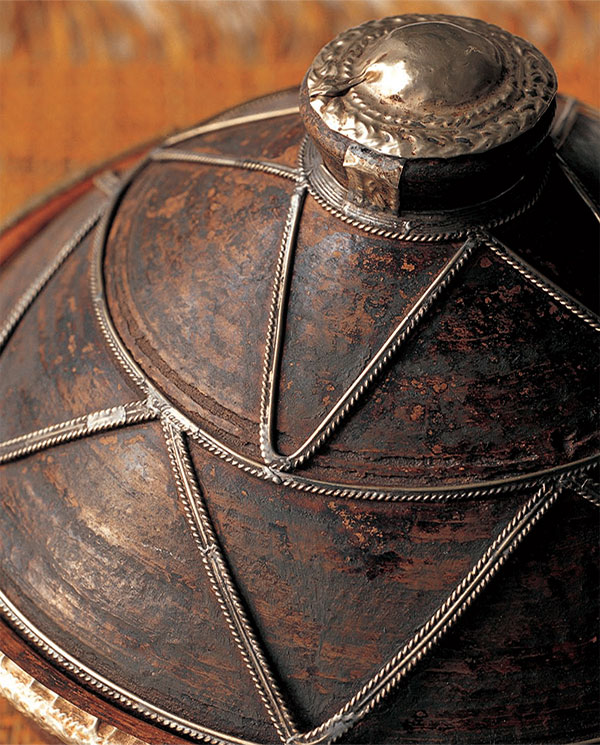 RYLAND PETERS & SMALL LONDON NEW YORK TAGINES & COUSCOUS Delicious recipes for Moroccan one-pot cooking Ghillie Baan photography by Martin Brigdale and Peter Cassidy Design and Photographic Art Direction Steve Painter Senior Commissioning Editor Julia Charles Production Controller Toby Marshall Art Director Leslie Harrington Publishing Director Alison Starling Photography Martin Brigdale and Peter Cassidy Food Stylists Ross Dobson, Bridget Sargeson and Lucy McKelvie Prop Styling Helen Trent, Martin Brigdale and Steve Painter, Indexer Hilary Bird First published in the United Kingdom in 2010 by Ryland Peters & Small 2021 Jockeys Fields London WC1R 4BW www.rylandpeters.com 10 9 8 7 6 5 4 3 2 1 Text Ghillie Baan 2007, 2008, 2010 Design and photographs Ryland Peters & Small 2007, 2008, 2010 Printed in China The authors moral rights have been asserted. All rights reserved. No part of this publication may be reproduced, stored in a retrieval system, or transmitted in any form or by any means, electronic, mechanical, photocopying, or otherwise, without the prior permission of the publisher. EISBN: 978 1 84975 673 0 ISBN: 978 1 84597 947 8 A CIP record for this book is available from the British Library. Some of the recipes in this book have been published previously by Ryland Peters & Small in Tagine and Flavours of Morocco.Notes All spoon measurements are level. All eggs are medium, unless otherwise specified.
RYLAND PETERS & SMALL LONDON NEW YORK TAGINES & COUSCOUS Delicious recipes for Moroccan one-pot cooking Ghillie Baan photography by Martin Brigdale and Peter Cassidy Design and Photographic Art Direction Steve Painter Senior Commissioning Editor Julia Charles Production Controller Toby Marshall Art Director Leslie Harrington Publishing Director Alison Starling Photography Martin Brigdale and Peter Cassidy Food Stylists Ross Dobson, Bridget Sargeson and Lucy McKelvie Prop Styling Helen Trent, Martin Brigdale and Steve Painter, Indexer Hilary Bird First published in the United Kingdom in 2010 by Ryland Peters & Small 2021 Jockeys Fields London WC1R 4BW www.rylandpeters.com 10 9 8 7 6 5 4 3 2 1 Text Ghillie Baan 2007, 2008, 2010 Design and photographs Ryland Peters & Small 2007, 2008, 2010 Printed in China The authors moral rights have been asserted. All rights reserved. No part of this publication may be reproduced, stored in a retrieval system, or transmitted in any form or by any means, electronic, mechanical, photocopying, or otherwise, without the prior permission of the publisher. EISBN: 978 1 84975 673 0 ISBN: 978 1 84597 947 8 A CIP record for this book is available from the British Library. Some of the recipes in this book have been published previously by Ryland Peters & Small in Tagine and Flavours of Morocco.Notes All spoon measurements are level. All eggs are medium, unless otherwise specified. Uncooked or partially cooked eggs should not be served to the very young, the elderly, those with a compromised immune system or pregnant women. When a recipe calls for the grated zest of citrus fruit, buy unwaxed fruit and wash well before using. If you can only find treated fruit, scrub well in warm soapy water and rinse before using. Sterlize preserving jars before use. Wash in hot soapy water and rinse in boiling water. Place in a large saucepan, cover with hot water, bring to the boil and boil, covered, for 15 minutes.
Turn off the heat and leave in the hot water until using. Invert onto kitchen towel to dry. Sterlize lids for 5 minutes, by boiling. Jars should be filled while hot. Ovens should be preheated to the specified temperature. Recipes in this book were tested in a regular oven.
If using a fan-assisted oven, follow the makers instructions for adjusting temperatures. 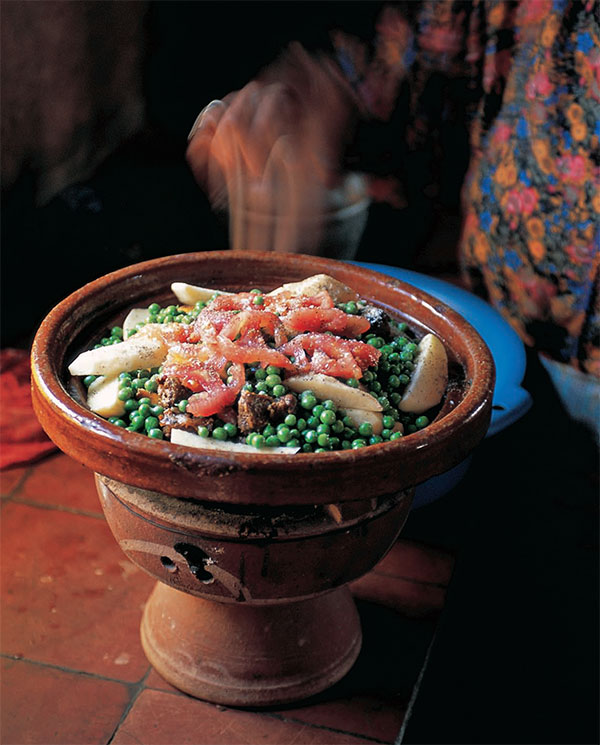 Colourful, decorative, scented and a feast for the senses the food of Morocco reflects a fascinating mix of the cultures that have left their mark on the region: the indigenous Berbers with their tradition of tagine cooking and couscous; the nomadic Bedouins from the desert who brought dates, milk and grains; the Moors expelled from Spain who relied heavily on olives and olive oil and brought with them the Andalusian flavours of paprika and herbs; the Sephardic Jews with their preserving techniques employing salt; the Arabs who introduced the sophisticated cuisine from the Middle East; the Ottoman influence of kebabs and pastry making; and finally, the finesse of the French. The root of Moroccan cooking can be traced back to the indigenous Berber tribes. Steeped in tradition, the rural Berbers are proud of their ancestry. They have lived in North Africa, between Egypt and the western coast of Morocco, as far back as archaeological records go. Originally farmers, living alongside the nomadic Taureg and Bedouin tribes of the desert, the Berbers would have made an impact on the food of the region long before the invasion of the Arabs and, although they had to convert from Christianity to Islam and adopt new religious and culinary customs, they are keen to make the point that they are not of Arab descent.
Colourful, decorative, scented and a feast for the senses the food of Morocco reflects a fascinating mix of the cultures that have left their mark on the region: the indigenous Berbers with their tradition of tagine cooking and couscous; the nomadic Bedouins from the desert who brought dates, milk and grains; the Moors expelled from Spain who relied heavily on olives and olive oil and brought with them the Andalusian flavours of paprika and herbs; the Sephardic Jews with their preserving techniques employing salt; the Arabs who introduced the sophisticated cuisine from the Middle East; the Ottoman influence of kebabs and pastry making; and finally, the finesse of the French. The root of Moroccan cooking can be traced back to the indigenous Berber tribes. Steeped in tradition, the rural Berbers are proud of their ancestry. They have lived in North Africa, between Egypt and the western coast of Morocco, as far back as archaeological records go. Originally farmers, living alongside the nomadic Taureg and Bedouin tribes of the desert, the Berbers would have made an impact on the food of the region long before the invasion of the Arabs and, although they had to convert from Christianity to Islam and adopt new religious and culinary customs, they are keen to make the point that they are not of Arab descent.
Many rural Berber communities speak their own languages and dialects but those who are literate also speak Arabic and, in some areas, French. Berbers also fiercely uphold some of their own culinary customs, such as the festive pilgrimages, moussems, which are held in tented enclosures where traditional dishes, such as couscous, are cooked in vast quantities and shared. Another feature of Berber culinary life is the diffa, which is a festive banquet, varying in content in accordance with the wealth of the family, to mark special family occasions such as weddings and births and religious events. It is Berbers we have to thank for tagines and couscous. A tagine is a glorified stew worthy of poetry aromatic and syrupy, zesty and spicy, or sweet and fragrant are just some of the words that come to mind. It is a dish of tender meat, fish or succulent vegetables, simmered to perfection in buttery sauces with fruit, herbs, honey and chillies.
An authentic tagine is in a class of its own and has become a fundamental feature of Moroccan cuisine. The name tagine (sometimes spelled tajine) is also given to the vessel in which the food is cooked: a shallow, round, earthenware pot with a unique conical lid designed to lock in moisture and flavours. In it, the food cooks gently in a small amount of liquid. The finished dish can either be served piping hot straight from its cooking vessel, or tipped into one of the decorative versions of the pot, glazed in beautiful shades of blue and green, to take to the table. Although originally a Berber dish, the tagine has evolved with the history of the region as waves of Arab and Ottoman invaders, Moorish refugees from Andalusia and French colonialists have left their influences on the cuisine. Classic tagines include combinations of lamb with dried prunes or apricots; chicken with preserved lemon and green olives; ) which is very much an acquired taste! The method employed in tagine cooking also varies from the countryside to the cities.
In the north, in cities like Tangier and Casablanca, where the Spanish and French influences are evident, the meat is often browned in butter or oil and the spices and onions are sauted before adding the rest of the ingredients, whereas Fassi and Marrakchi tagines are often prepared by putting all the ingredients together in water and then adding extra butter or smen towards the end of the cooking time. Traditionally, tagines are served as a course on their own, with freshly baked flat breads or crusty bread to mop up the delectable syrupy sauces, and are followed by a mound of couscous. The more modern way is to combine the courses and serve them with an accompanying salad or vegetable side dish. On festive occasions, the custom is to pile up a huge pyramid of couscous and hollow out the peak to form a well into which the tagine is spooned. However, most earthenware tagines are not big enough to cope with feasts, so large copper pots are often used instead. The great secret of an authentic tagine is to simmer the ingredients over a low heat, so that everything remains deliciously moist and tender.
Meat tagines may be cooked for several hours, the meat simmering gently in a seasoned, fragrant liquid until it is so tender it almost falls off the bone. Generally, dishes of vegetables, pulses or fish do not require long cooking times but still benefit from the tagine method in terms of enhanced taste and texture. Traditionally, tagines are cooked over a clay stove, or brazier, which is stoked with charcoal to maintain constant heat. Such stoves diffuse the heat around the base of the tagine, enabling the liquid to reduce and thicken without drying out. Wood-burning ovens and open fires are used, too. However, wonderful tagines can also be produced using a modern hob or oven.
Font size:
Interval:
Bookmark:
Similar books «Tagines & couscous : delicious recipes for Moroccan one-pot cooking»
Look at similar books to Tagines & couscous : delicious recipes for Moroccan one-pot cooking. We have selected literature similar in name and meaning in the hope of providing readers with more options to find new, interesting, not yet read works.
Discussion, reviews of the book Tagines & couscous : delicious recipes for Moroccan one-pot cooking and just readers' own opinions. Leave your comments, write what you think about the work, its meaning or the main characters. Specify what exactly you liked and what you didn't like, and why you think so.

